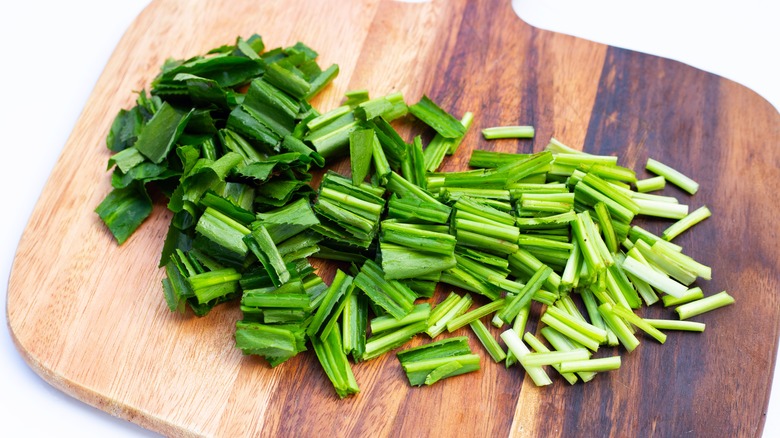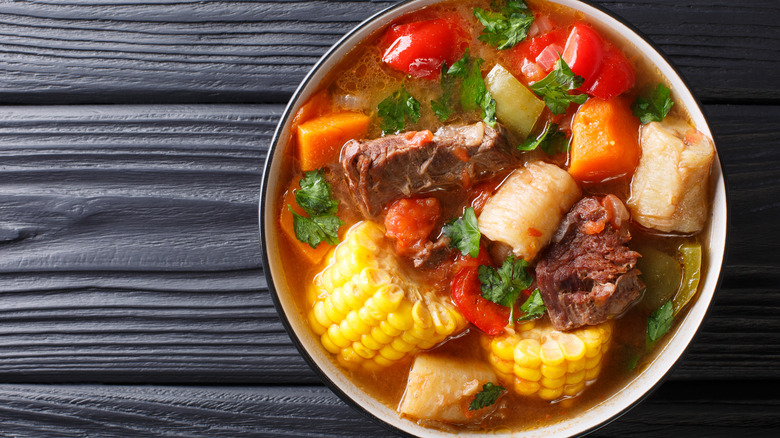What Is Culantro And How Is It Different From Cilantro?
If you've ever ordered pho, you've probably tried culantro. Culantro (Eryngium foetidum) is a deeply aromatic herb popular in cuisines of parts of Asia and Latin America. Because of its geographic spread, it goes by a lot of different names. Some refer to it as "long coriander," "recao," "ngo gai," or "cilantro de hoja ancha" (which translates to wide-leaf cilantro from Spanish), and many other monikers. Even though cilantro and culantro are sometimes used in place of each other, they are not the same herb.
Cilantro and culantro have a lot of overlaps, but there are important distinctions in preparation and taste. Understanding both the differences and the similarities can help you get the most out of both. Culantro is an herb that sometimes flies under the radar in areas where it isn't as common, such as in the United States; however, for many, this flavor-amplifying herb is a kitchen staple they cannot go without.
What is culantro?
Culantro belongs to the family Apiaceae, which also includes similar herbs like cilantro and parsley, as well as some root vegetables like turnips and carrots. Culantro's native range is in the tropical regions of the Americas. Despite the fact that cilantro is a popular herb in Mexican cuisine today, it was actually introduced to the region by the Spanish sometime in the 1500s. Culantro, on the other hand, is cilantro's native counterpart in the Americas. Meanwhile, Europeans are thought to have brought culantro from the Caribbean over to Southeast Asia, where it is now a popular ingredient in Thai and Vietnamese cooking.
As a plant, Culantro is low to the ground and grows leaves from the center, like lettuce. This makes harvest easy because you can collect the outer leaves as the plant matures. In places where culantro is commonly used, it adds depth and aromatic flavor to stews, marinades, and other popular dishes.
Culantro vs. cilantro
Even though their names are only different by a single letter, cilantro and culantro are easy to distinguish visually. While cilantro looks similar to parsley with its papery, duck-foot leaves on a thin stem, culantro's leaves more closely resemble small spears. An advantage of culantro is you do not have to remove it from a stem before use, as with cilantro. Culantro is known to have a similar taste to cilantro, but it has an amplified potency. As a result, many people don't treat these as a one-to-one substitution. In general, you can use less culantro than cilantro.
In the United States, the other notable practical difference between the two is that cilantro is pretty ubiquitous. You can find it in chain grocery stores very easily. Culantro is less common in the United States, and you may have better luck at Latin or Asian grocers or farmer's markets than at big chains. Of course, availability is all dependent on where in the world you are.
What does culantro taste like?
The flavor of culantro is often compared to cilantro, but much stronger. Many people say that the strength of the flavor is so potent that you will get a strong whiff of it if you so much as brush up against it. The endurance of this herbaceous and slightly citrusy taste makes it an excellent note in longer-cooked recipes. Cooking the culantro is said to balance out the flavor. Because it is so strong, you don't need much of it to create a flavorful dish.
One common complaint about cilantro is that for a portion of the population, it tastes like soap. This is due to a genetic predisposition. Culantro may or may not trigger the same effect in people, so if you are averse to cilantro, it is best to approach culantro with caution. But if you like the taste of cilantro, you will likely find culantro to be quite agreeable.
How to cook with culantro?
Cooking with culantro is similar to cooking with many other herbs in terms of preparation. In direct comparison to cilantro, it is a little bit easier to chop because you don't have to remove the stem it first. Also, since the flavor is so much stronger than cilantro, you can use less of it.
One difference between cooking with culantro and cooking with cilantro is that cilantro is often eaten fresh, while culantro's leaves and flavor are hearty enough to make it a good addition to longer-cooked meals such as stews and marinades. It is not as heat-sensitive as cilantro. Chop or shred the culantro leaves to get the most out of their deeply aromatic flavor. Add culantro to Puerto Rican sofrito, a blend that adds bursts of flavor to everything it touches, or simmer it in a big brothy pot of sancocho, a delicious South American soup.
Where to buy culantro
If you're located in one of the regions across the world where culantro is popular, it's likely that it won't be hard to find it for sale — but in the United States, cilantro is the herb that you're more likely to find in big chain grocery stores, not culantro. If you are on the hunt for some, you may have better luck in an Asian or Latin American grocer. You should also try local farmer's markets for this herb.
If you're looking for culantro and keep striking out, you might try your hand at growing some. Culantro requires a warm environment, so if you live in a place that has cold winters, you might not experience the full biennial potential of culantro. However, if you plant it after the last frost of the season, you can keep the plant healthy all season. Plant culantro in a mostly shaded area in soil that won't hold water. Throughout the season, you can pick leaves as needed, as you would with lettuce.
Nutritional information about culantro
As culantro is an herb, and a particularly flavorful one at that, it is rare that you eat very much in one serving. However, as much as culantro packs a punch in flavor, it also contains many nutrients. The herb is known to be a source of calcium and carotene, as well as a source of riboflavin, iron, vitamin A, and vitamin C.
Culantro has some medicinal qualities and is sometimes brewed as a tea known for its anti-inflammatory and pain-relieving properties. Ailments that people might drink this tea for include constipation, fevers, and more. It has also been used as a stimulant for appetite. Consult a health professional before using culantro to treat serious illness, but overall, having some culantro in your produce drawer (or better yet, in your garden) means having access to an herb that is both good for you and abundantly flavorful.






